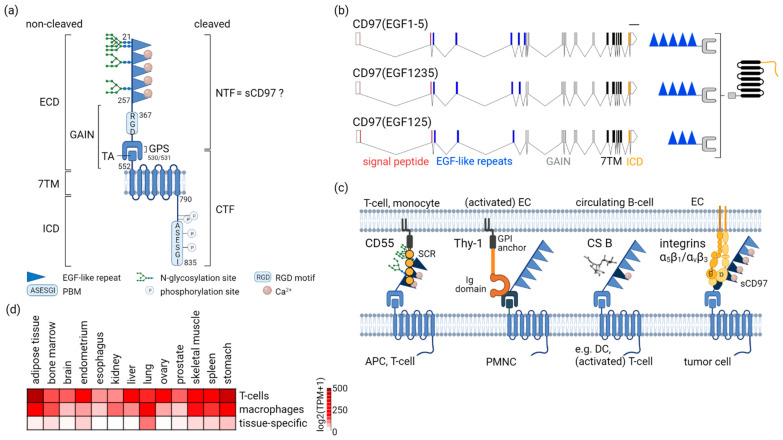Figure 1.
Common features of human CD97. (a) Schematic structural organization of CD97. The figure depicts the 835 amino acid full-length CD97(EGF1-5) isoform without the signal peptide. CD97 has a tripartite structure with the ECD, containing tandemly-arranged EGF-like repeats and the GAIN domain, the 7TM helices, and the ICD. The potential N-glycosylation sites in the EGF-like repeats are indicated. EGF2-5 can bind Ca2+, which is important for CD97 interactions. CD97 is self-cleaved at the GAIN domain-covered GPS, resulting in a bipartite structure with the NTF and CTF. Circulating sCD97 likely is the released NTF. The N-terminus of the CTF represents the integrated TA sequence. The ICD contains many phosphorylation sites. Four are confirmed in more than five records in which this modification was assigned using proteomic discovery mass spectrometry (phosphosite.org, accessed on 4 February 2022). In CD97(EGF1-5), these sites are S818, T825, S831, and S833. The ICD ends up in a PBM. For abbreviations and further explanations, see the running text. (b) Exon/intron and protein structure of the three CD97/ADGRE5 isoforms. Alternative splicing results in isoforms with three to five EGF-like repeats with distinct binding properties. The isoforms are named CD97(EGF125), EGF(1235), and EGF(1-5), according to the EGF-like repeats present (wormweb.org, accessed on 15 March 2022). Intron: line; exon: solid bar; 5′/3′-UTR: empty bar; signal peptide: red; EGF-like repeats: blue; GAIN: grey; 7TM: black; ICD: orange; scale bar: 1000 base pairs (c) Interaction partners with the CD97 ECD. CD55 is a glycophosphatidylinositol (GPI)-anchored transmembrane receptor with four short consensus repeats (SCRs). The first three SCRs interact with at least three EGF-like repeats of CD97. Thy-1/CD90 is a small, heavily N-glycosylated GPI-anchored transmembrane receptor with a single extracellular immunoglobulin (Ig) domain. Thy-1 binding to CD97 on polymorphonuclear cells (PMNC) is calcium-independent and occurs through the GAIN domain. Binding to the glycosaminoglycan side chain chondroitin sulfate B (CS B), a component of the extracellular matrix and of cell surfaces proteoglycans, is mediated by the fourth EGF-like repeat of CD97. Thus, CS B interacts only with CD97(EGF1-5). Binding is Ca2+-dependent. Soluble recombinant CD97 interacts with integrins on endothelial cells (ECs) via its RGD motif and at least three EGF-like repeats. CS B can act synergistically. Interacting domains are indicated in dark blue. (d) ADGRE5 scRNAseq analysis in healthy normal human tissues. The analysis comprises all protein-coding genes in 144 individual cell type clusters (The Human Protein Atlas, proteinatlas.org; accessed on 7 February 2022). In the heat map, only tissues containing the clusters “T-cells” and “macrophages” are considered. Additionally, the tissue-specific cell type cluster with the highest ADGRE5 level is included (e.g., fat/adipocytes, lung/alveolar cells type 2, endometrium/smooth muscle cells, spleen/plasma cells, stomach/gastric mucus-secreting cells). Log2 transcripts per million (TPM) + 1 values are given. The figure was created with BioRender.com (accessed on 26 April 2022).

